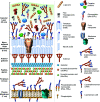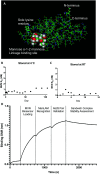The cyanobacterial lectin, microvirin-N, enhances the specificity and sensitivity of lipoarabinomannan-based TB diagnostic tests
- PMID: 33367346
- PMCID: PMC8374243
- DOI: 10.1039/d0an01725f
The cyanobacterial lectin, microvirin-N, enhances the specificity and sensitivity of lipoarabinomannan-based TB diagnostic tests
Abstract
Tuberculosis (TB) is one of the top ten causes of death globally, despite being treatable. The eradication of TB disease requires, amongst others, diagnostic tests with high specificity and sensitivity that will work at the point of care (POC) in low-resource settings. The TB surface glycolipid antigen, mannose-capped lipoarabinomannan (ManLAM) currently serves as the only POC molecular diagnostic biomarker suitable for use in low cost immunoassays. Here, we demonstrate the high affinity and exceptional specificity of microvirin-N (MVN), a 14.3 kDa cyanobacterial lectin, toward H37Rv TB ManLAM and utilize it to develop a novel on-bead ELISA. MVN binds to ManLAM with sub-picomolar binding affinity, but does not bind to other variants of LAM expressed by non-pathogenic mycobacteria - a level of binding specificity and affinity that current commercially available anti-LAM antibodies cannot achieve. An on-bead ELISA was subsequently developed using MVN-functionalized magnetic beads which allows for the specific capture of ManLAM from human urine with a limit of detection (LOD) of 1.14 ng mL-1 and no cross-reactivity when tested with PILAM, a variant of LAM found on non-pathogenic mycobacteria.
Conflict of interest statement
There are no conflicts of interest to declare.
Figures



Similar articles
-
The cell surface receptor DC-SIGN discriminates between Mycobacterium species through selective recognition of the mannose caps on lipoarabinomannan.J Biol Chem. 2003 Feb 21;278(8):5513-6. doi: 10.1074/jbc.C200586200. Epub 2002 Dec 20. J Biol Chem. 2003. PMID: 12496255
-
Aptamer Detection of Mycobaterium tuberculosis Mannose-Capped Lipoarabinomannan in Lesion Tissues for Tuberculosis Diagnosis.Front Cell Infect Microbiol. 2021 Mar 15;11:634915. doi: 10.3389/fcimb.2021.634915. eCollection 2021. Front Cell Infect Microbiol. 2021. PMID: 33791241 Free PMC article.
-
A Novel Sensitive Immunoassay Targeting the 5-Methylthio-d-Xylofuranose-Lipoarabinomannan Epitope Meets the WHO's Performance Target for Tuberculosis Diagnosis.J Clin Microbiol. 2018 Nov 27;56(12):e01338-18. doi: 10.1128/JCM.01338-18. Print 2018 Dec. J Clin Microbiol. 2018. PMID: 30257899 Free PMC article.
-
Application of lipoarabinomannan antigen in tuberculosis diagnostics: current evidence.Postgrad Med J. 2014 Mar;90(1061):155-63. doi: 10.1136/postgradmedj-2013-132053. Epub 2014 Jan 15. Postgrad Med J. 2014. PMID: 24429376 Review.
-
Impact of diagnostic strategies for tuberculosis using lateral flow urine lipoarabinomannan assay in people living with HIV.Cochrane Database Syst Rev. 2021 Aug 20;8(8):CD014641. doi: 10.1002/14651858.CD014641. Cochrane Database Syst Rev. 2021. PMID: 34416013 Free PMC article.
Cited by
-
KLK12 Regulates MMP-1 and MMP-9 via Bradykinin Receptors: Biomarkers for Differentiating Latent and Active Bovine Tuberculosis.Int J Mol Sci. 2022 Oct 14;23(20):12257. doi: 10.3390/ijms232012257. Int J Mol Sci. 2022. PMID: 36293113 Free PMC article.
References
-
- World Health Organization, Global Tuberculosis Report 2018, World Health Organization, S.l., 2018
-
- Pai M. Nicol M. P. Boehme C. C. Microbiol. Spectrum. 2016;4:5. - PubMed
MeSH terms
Substances
Grants and funding
LinkOut - more resources
Full Text Sources
Other Literature Sources
Medical

